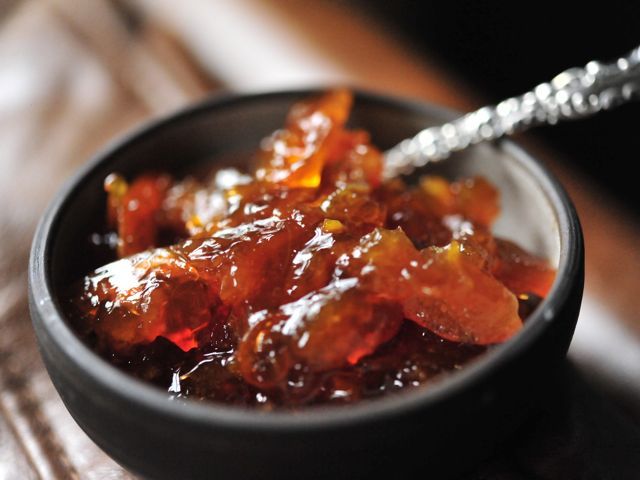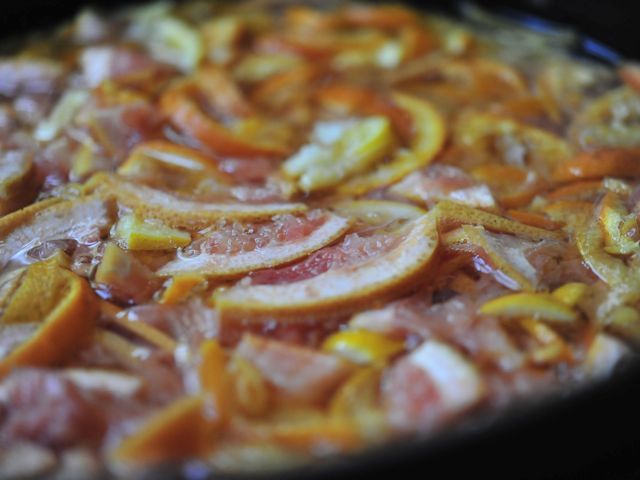3.23.11 Lady Marmalade
Of late, when it comes to preserves of the non-meat variety, I have been turning to The River Cottage Preserves Handbook by Pam Corbin. It's a gorgeous little book, clearly written with lots of handy tips. I've made the fruit leather with great success, and can't wait to try the homemade bouillon. Her marmalade recipe calls for the elusive Seville orange, but also says that you can substitute a mixture of sweet oranges, lemons and grapefruits. I used what I had on hand: mostly kishu mandarins, with a couple of Meyer lemons and one big pink grapefruit thrown in. A large, heavy pot really makes all the difference when you're cooking up jam, as it conducts heat better and prevents burning. My enormous copper stockpot is a dream. With that and my gigantic wooden spoon I feel like a domesticated Amazon (of the warrior variety, not the online megastore).
According to Pam, you can make marmalade by simply boiling the fruit whole, but she recommends you endure the tedium of first juicing the fruit and then slicing all the peel, which I did, and which I actually found quite delightfully fragrant and pleasantly meditative. Try it. It's only 2 1/4 pounds for god's sake. Then you soak it all in lots of water; I left mine out on the counter overnight. The next day you boil it for a couple of hours, stir in lots of sugar and some lemon juice, and cook it down some more. I have to say, mine bubbled away for quite a bit longer than the 25 minutes stated in this recipe. (Almost 2 hours!) I love it when it gets all dark and sticky, but still molten and malleable enough to ladle easily into jars.
As far as the jars, if you have a dishwasher, you can sterilize them by running them through a hot cycle. Otherwise, my preferred method is to wash them in hot soapy water and dry them in a low oven on a clean dish towel spread on a cookie sheet. Keep them in the oven until the jam is about done, then carefully remove them and place on the counter on a clean dish towel. Sterilize new sealing lids in boiling water. Have all this at the ready, and then ladle the hot, finished jam into the jars, pop on the lids, screw them "fingertip tight" and leave the jars to sit on top of a clean cloth for several hours or overnight without moving. After a while, you will hear the satisfying pop of the seal forming. A noise that may just distract you from the pain of winter and from the hot shower you cannot take.
Winter Citrus Marmalade
makes about 5-6 pints
- — 2 1/4 pounds mixed winter citrus, or Seville oranges
- — 1/3 cup lemon juice
- — 10 cups Demerara sugar or other good quality cane sugar
Scrub the oranges, remove the buttons at the top of the fruit, then cut in half. Squeeze out the juice and keep to one side. Using a sharp knife, slice the peel, pith and all, into thin, medium or chunky shreds, according to your preference. Put the sliced peel into a bowl with the orange juice and cover with 10 cups of water. Leave to soak overnight, or for up to 24 hours.
Transfer the whole mixture to a preserving pan (or a big, heavy pot), bring to the boil, then simmer slowly, covered, until the peel is tender. This should take about 2 hours, by which time the contents should have reduced by about one third. (Mine really didn't seem to be that reduced, but it wasn't a problem, although later I did end up cooking it almost an additional 2 hours.)Stir in the lemon juice and the sugar. Bring the marmalade to a boil, stirring until the sugar has dissolved. Boil rapidly until the setting point is reached*, about 20-25 minutes (or, of you're me, until it's q rich dark color and getting rather sticky). Remove from the heat. Leave to cool for 8-10 minutes—a little longer if the peel is in chunky pieces—then stir gently to disperse any scum. Pour into warm, sterilized jars and seal immediately. Use within 2 years.
*To determine the setting point: it's either 220º, if you have a thermometer, or the point at which it passes the crinkle test. The Crinkle Test: Drop a little jam onto a cold saucer (put it in the fridge when you start making the jam). Allow to cool for a minute, then push gently with your fingertip. If the jam crinkles, you've reached the setting point.
 Download Recipe
Download Recipe








2 Comments